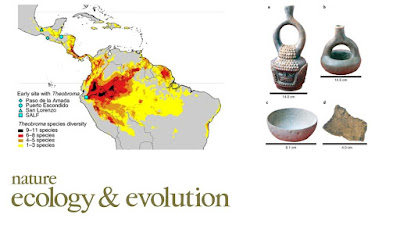miércoles, 31 de octubre de 2018
martes, 30 de octubre de 2018
.
Gridded Livestock of the World
.
This dataverse contains peer-reviewed spatial dataset on livestock
distribution for applications in development, environment and health. It
contains the most up to date version of GLW 3 for the reference year
2010 and the following species: cattle, sheep, goats, buffaloes, horses,
pigs, chickens and ducks. The individual species datasets are available
at global extent and 5 minutes of arc resolution (approx. 10 km at the
equator).
.
.
The use and domestication of Theobroma cacao during the mid-Holocene in the upper Amazon
Zarrillo et al.
The use and domestication of Theobroma cacao during the mid-Holocene in the upper Amazon
Zarrillo et al.
Cacao (Theobroma cacao L.) is an important economic crop, yet studies of its domestication history and early uses are lim- ited. Traditionally, cacao is thought to have been first domesticated in Mesoamerica. However, genomic research shows that T. cacao’s greatest diversity is in the upper Amazon region of northwest South America, pointing to this region as its centre of origin. Here, we report cacao use identified by three independent lines of archaeological evidence—cacao starch grains, absorbed theobromine residues and ancient DNA—dating from approximately 5,300 years ago recovered from the Santa Ana-La Florida (SALF) site in southeast Ecuador. To our knowledge, these findings constitute the earliest evidence of T. cacao use in the Americas and the first unequivocal archaeological example of its pre-Columbian use in South America. They also reveal the upper Amazon region as the oldest centre of cacao domestication yet identified.
Locations of the four archaeological sites in Mexico, Central America and South America with the earliest evidence of Theobroma use, as well as the species diversity distributions for the genus Theobroma 17,19,58 . The zone surrounding SALF has six known native species of Theobroma: T. bicolor; T. sinuosum; T. speciosum; T. subincanum; T. stipulatum; T. glaucum 58 . The species diversity map is derived from ref. 17 and is modelled using species observations extracted from GBIF 58 . We reduced the modelled continuous 1–11 species diversity range of Thomas et al. 17 to four categories: 1–3, 4–5, 6–8 and 9–11 species.
.
.
lunes, 29 de octubre de 2018
domingo, 28 de octubre de 2018
sábado, 27 de octubre de 2018
.
The role of plant epigenetics in biotic interactions
Conchita Alonso Daniela Ramos‐Cruz Claude Becker
The role of plant epigenetics in biotic interactions
Conchita Alonso Daniela Ramos‐Cruz Claude Becker
Plants are hubs of a wide range of biotic interactions with mutualist and antagonist animals, microbes and neighboring plants. Because the quality and intensity of those relationships can change over time, a fast and reversible response to stress is required. Here, we review recent studies on the role of epigenetic factors such as DNA methylation and histone modifications in modulating plant biotic interactions, and discuss the state of knowledge regarding their potential role in memory and priming. Moreover, we provide an overview of strategies to investigate the contribution of epigenetics to environmentally induced phenotypic changes in an ecological context, highlighting possible transitions from whole‐genome high‐resolution analyses in plant model organisms to informative reduced representation analyses in genomically less accessible species.
.
.
viernes, 26 de octubre de 2018
.
"If you truly love nature you will find beauty everywhere"
Vincent Van Gogh
.
"If you truly love nature you will find beauty everywhere"
Vincent Van Gogh
.
Fight Hunger and Cool the C... by on Scribd
jueves, 25 de octubre de 2018
BIOLOGÍA SINTÉTICA vs. AGRO... by on Scribd
miércoles, 24 de octubre de 2018
.
Herbivore specificity and the chemical basis of plant–plant communication in Baccharis salicifolia (Asteraceae)
Xoaquín Moreira Colleen S. Nell Angelos Katsanis Sergio Rasmann Kailen A. Mooney
.
https://nph.onlinelibrary.wiley.com/doi/abs/10.1111/nph.14164#.W9Bunduq5cA.twitter
.
Herbivore specificity and the chemical basis of plant–plant communication in Baccharis salicifolia (Asteraceae)
Xoaquín Moreira Colleen S. Nell Angelos Katsanis Sergio Rasmann Kailen A. Mooney
It is well known that plant damage by leaf‐chewing herbivores can induce resistance in neighbouring plants. It is unknown whether such communication occurs in response to sap‐feeding herbivores, whether communication is specific to herbivore identity, and the chemical basis of communication, including specificity.
We carried out glasshouse experiments using the California‐native shrub Baccharis salicifolia and two ecologically distinct aphid species (one a dietary generalist and the other a specialist) to test for specificity of plant–plant communication and to document the underlying volatile organic compounds (VOCs).
We show specificity of plant–plant communication to herbivore identity, as each aphid‐damaged plant only induced resistance in neighbours against the same aphid species. The amount and composition of induced VOCs were markedly different between plants attacked by the two aphid species, providing a putative chemical mechanism for this specificity. Furthermore, a synthetic blend of the five major aphid‐induced VOCs (ethanone, limonene, methyl salicylate, myrcene, ocimene) triggered resistance in receiving plants of comparable magnitude to aphid damage of neighbours, and the effects of the blend exceeded those of individual compounds.
This study significantly advances our understanding of plant–plant communication by demonstrating the importance of sap‐feeding herbivores and herbivore identity, as well as the chemical basis for such effects.
..
https://nph.onlinelibrary.wiley.com/doi/abs/10.1111/nph.14164#.W9Bunduq5cA.twitter
.
lunes, 22 de octubre de 2018
sábado, 20 de octubre de 2018
viernes, 19 de octubre de 2018
Cuando la alimentación se h... by on Scribd
martes, 16 de octubre de 2018
BREAKING AWAY FROM INDUSTRI... by on Scribd
lunes, 15 de octubre de 2018
sábado, 13 de octubre de 2018
CONSECUENCIAS DEL ESPACIO E... by on Scribd
miércoles, 10 de octubre de 2018
martes, 9 de octubre de 2018
domingo, 7 de octubre de 2018
.
Veritatem inquirenti, semel in vita de omnibus, quantum fieri potest, esse dubitandum
René Descartes
.
Veritatem inquirenti, semel in vita de omnibus, quantum fieri potest, esse dubitandum
René Descartes
.
Suscribirse a:
Comentarios (Atom)

































